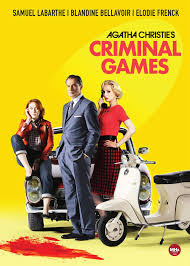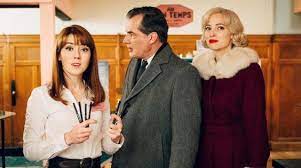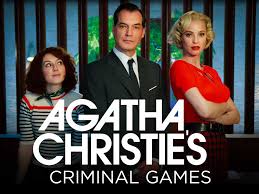IMdB meta-data is 42 episodes (for all three seasons) of 90m each, rated 7.6 by 1067 cinematizens.
Genre: krimi, species Christie.
Verdict: Delicieux!

Season Two is set in the 1950s to the mid-1960s, specifically after 1954 because that is when the très moderne Facel Vega coupé automobile driven by one character came (briefly) on to the market. The ensemble cast includes the dumb blonde in the office, the super cop, and the ambitious and impetuous journalist. It is set in Le Nord, near, but not in the city of Lille. There is plenty of the rain for which the North is famous.
Supercop learns to appreciate the goodhearted simplicity of the blonde secretary who painfully types his reports, exploits a journalist’s youthful fearlessness to blunder into situations, and they in turn appreciate his tenacity in ferreting out la verité, as Maigret would say.
The plots are derived from Agatha Christie, some from the Tommy and Tuppence sequence, others from Dame Marple, and Monsieur Poirot, aussi, but re-potted into French soil, and given a French twist.
While Supercop is a man of many talents, we are spared a backstory and he does not have a painful private life (so trivialised in most cop shows). Indeed, he seems to have little private life at all but he does like slamming up crims.
The redheaded journalist has two first names, Alice Avril, and provides the energy. Marlène the secretary is the emoting and emotional sounding board, while Supercop is the electronic brain. Together they are a kind of family of siblings. He is the older brother who enjoys teasing and tormenting the younger sister journalist, while ignoring the older clothes-horse secretary whose head is full of romantic nonsense from women’s magazines.
Loved the episode where he got a mobile phone in 1954. Yep, a war surplus US Army field telephone the size of a suitcase, which he carried around only to have the Telecom reception drop out at crucial moments. Very realistic. Minitel would have to wait.
Although many changes have been made from the sources, the villains remain the same, in so far as I recall the Dame’s stories. When the ghosts appear in Silent Witness, no effort is made to offer a Cartesian explanation, Horatio.
The touch is light, the movement is brisk, the dialogue sparkles, the villains are ever so polite, though too often the immediate effort to avoid an investigation by labelling the death a suicide or an accident is clumsy and irritating. The worst example is the L’affaire Prothero. Memo to script writers, stop messing about and let the team get on with it. Though in that episode the victim is so repellent we could hardly wait for his demise.
On the other hand, there are occasional dream sequences that are a hoot, as when the journalist is confronted by a dissatisfied and armed reader! (Dare we hope Rupert Moloch has such dreams?) When Marlène gets carried away in a romantic revery straight out of the women’s magazines she devours every day. Or when Supercop realises he cares about each of them and recoils in horror because his armour has rusted. Then there is the singular appearance of his anti-Cartesian mother, the mystic. More mère, please.
The tomboyish journalist has some Cinderella transformations.

There is also some superb acting when the script calls for it. The episode when it seems Marlène has been murdered elicits terrific performances from both Supercop and Journalist as they realise how much they loved her for all her genial incompetence. And Marlène plays a double role as herself and her dowdy, miserable sister. Chapeaux! A reverse Cinderella. Even more memorable is one character actor who says not a line, but the guilt, fear, and shame that cross her face are remarkable in two short scenes.
Anachronisms, there a few. In one episode a school teacher remarks in passing that she is ’gay.’ Surely no school teacher in 1954 would publicly to admit to being a lesbian to anyone, still less a police officer, though Marlène’s stupefied reaction is of the time and place.
Seasons One and Three are set in different time periods with different casts, and from a brief look they do not appeal to me. Each season had six episodes but this team was so popular more and more were made over the years to a total of twenty-seven. Season One is set in the 1930s and Three in the latter 1960s.
These are available on You Tube with subtitles. As always with You Tube, it is best to be quick. There are indications that more have been made and the search has begun. Some episodes can be found subtitled on DVD called (Agatha Christie’s) Criminal Games. Good luck.

